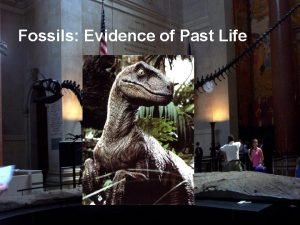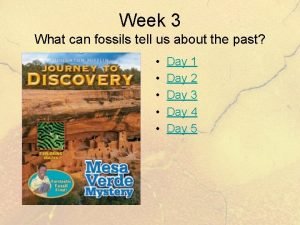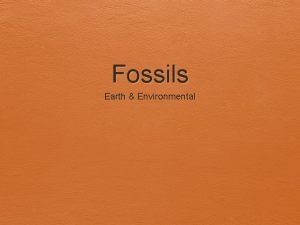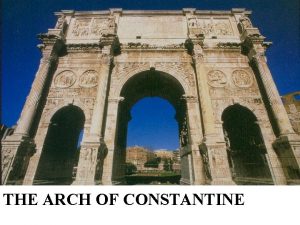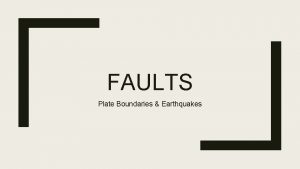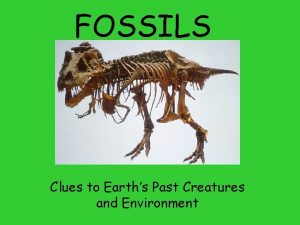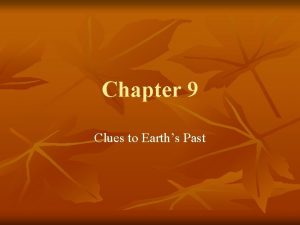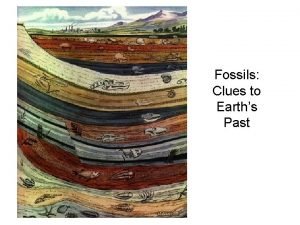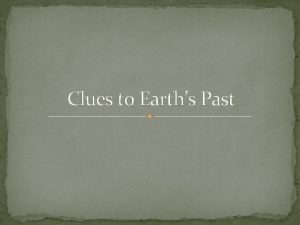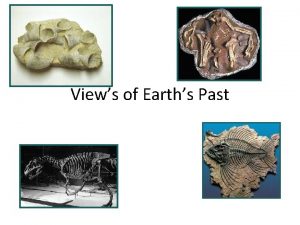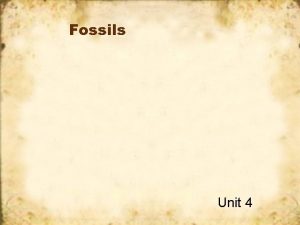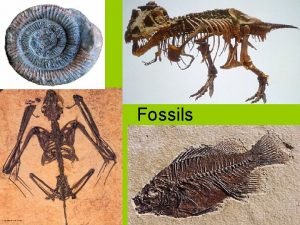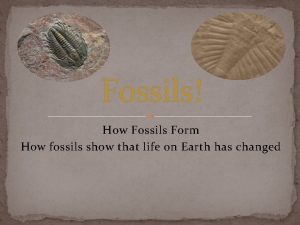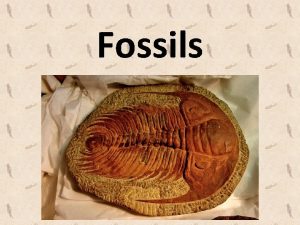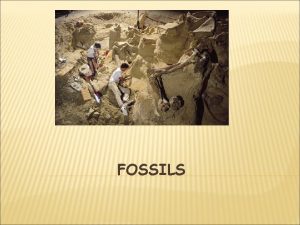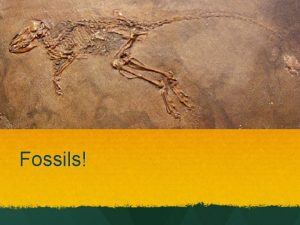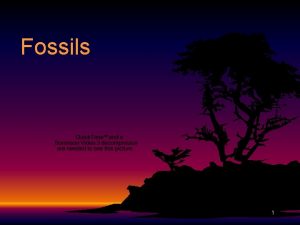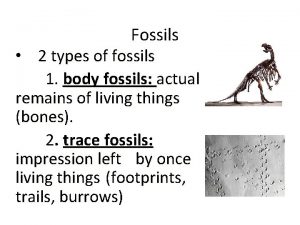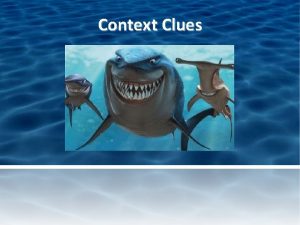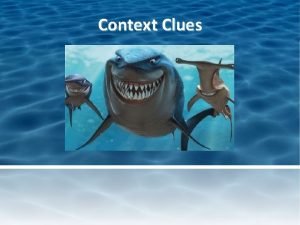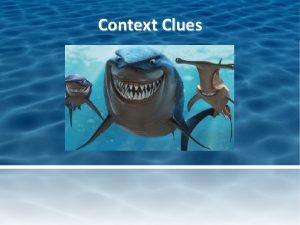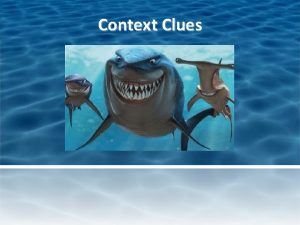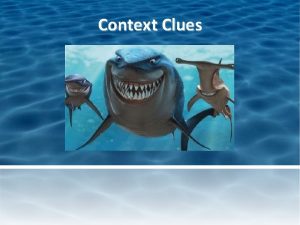Clues to the Earths Past What are fossils






























- Slides: 30

Clues to the Earth’s Past

What are fossils? n n Fossils are preserved remains or traces of living things. Most fossils form when living things die and are buried by sediments. The sediments slowly harden into rock and preserve the shapes of the organisms. Paleontologists are scientists who study fossils.

What they tell us Fossils provide evidence of how life has changed over time. n Fossils help scientists infer how Earth’s surface has changed. n Fossils are clues to what past environments were like. n

What they tell us n n The fossil record provides evidence about the history of life on Earth. The fossil record also shows that different groups of organisms have changed over time. Extinct is if an organism no longer exists and will never again live on Earth.

Types of fossils n n n Petrified fossils Molds and casts Carbon films Trace fossils Original remains

Petrified Fossils n n Fossils in which minerals replace all or part of an organism. How does this happen? n n Water rich in dissolved minerals seeped into spaces, evaporated, leaving the hardened minerals behind. Example – petrified wood




Molds and Casts n n Most common type of fossil. Both copy the shape of the organism. A mold is a hollow area of sediment in the shape of the organism. A cast is a copy of the shape of an organism.

Cast Mold

Carbonaceous Films n n Carbon film is an extremely thin coating of carbon on rock. How does this happen? n All organisms are made of carbon. When they are buried, the materials that make up the organism evaporates. These gases escape leaving carbon behind.


Trace Fossils n Trace fossils provide evidence of the activities of ancient organisms. n Examples A footprint provide clues about the size and behavior, the speed, how many legs it walked on, lived alone or with others. n A trail or burrow can give clues about the size and shape of the organism, where it lived, and how it obtained food. n


Original Remains n Preservation of remains with little or no change. n Preservation material n Tar n n Amber n n The sticky oil that seeps from Earth’s surface. Tar soaks into the organisms bones, preserving the bones from decay. Ice The hardened resin, or sap, of trees. The amber seals the organism from the air protecting it from decay.


Otzi the iceman


The Rock Record n Relative time is based primarily upon fossils and superposition. n n Relative time places events in a sequence – not actual date of occurrence. Absolute time is called measured time. n Absolute time identifies actual date of the event.

Index fossils n Index fossil identify the relative age of a rock. n n Fossil typical of a particular time in Earth’s history. What determines an index fossil? n n n Easily recognizable Widespread Limited in time.


The Rock Record Main Ideas How do you find age with Relative Time? Details Principal of original horizontality – sedimentary rocks are deposited in horizontal layers • Law of superposition – in undisturbed sedimentary rocks, oldest rocks will be at the bottom, youngest at the top. • Law of cross-cutting relationships – an igneous rock is younger than the rocks it has intruded or cut across.

Sandstone was deposited in horizontal layers Oldest rocks at bottom, youngest rocks at top

Basalt flow is younger than sandstone below it, but older than shale above it. Younger granite dike cuts across sandstone and shale.

The Rock Record Details Main Ideas How do you find age with Relative Time? • Law of included fragments – pieces of one rock must be older when found inside another rock older • Unconformity – the rock record is missing. A gap in geologic time.

Unconformity is a gap in the rock record

Sequence of events – unconformity 1. Sediments (G) deposited 2. Sediments (G) folded 3. Sediments (G) eroded 4. Sediments S, H, and L deposited 5. Magma (B) reaches surface as lava flow

Practice

More Practice
 Mikael ferm
Mikael ferm Boda-boda types of clues
Boda-boda types of clues Fossils evidence of past life
Fossils evidence of past life What can fossils tell us
What can fossils tell us Fossil types
Fossil types Best index fossil
Best index fossil Whats earths moon called
Whats earths moon called Earths interior
Earths interior Earths orbit seasons
Earths orbit seasons Earths biomes
Earths biomes 4 spheres of the earth
4 spheres of the earth The emperor constantine i recycled sculpture
The emperor constantine i recycled sculpture Whats the name of earths moon
Whats the name of earths moon Whats the thickest layer of the earth
Whats the thickest layer of the earth What does the earths tilt cause
What does the earths tilt cause The earth's layers foldable
The earth's layers foldable Brown earth soil profile
Brown earth soil profile Most abundant element in earth's crust
Most abundant element in earth's crust What does earths tilt do
What does earths tilt do Earths mantle
Earths mantle Dinah earth's layers foldable
Dinah earth's layers foldable Earths early atmosphere contained
Earths early atmosphere contained Description of earth's atmosphere
Description of earth's atmosphere Earths roation
Earths roation Study of earth's physical features
Study of earth's physical features How thick is the earths crust
How thick is the earths crust Earths crust
Earths crust Earths major crustal plates
Earths major crustal plates What is this shape
What is this shape Whats earths moon called
Whats earths moon called Earths boundaries
Earths boundaries


